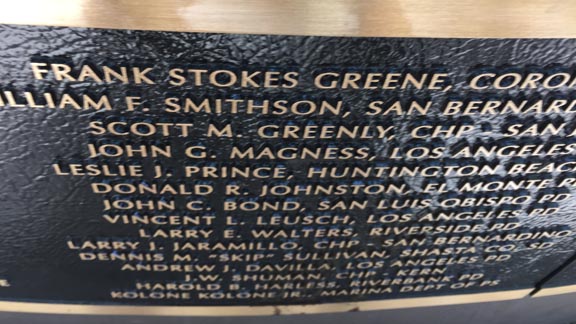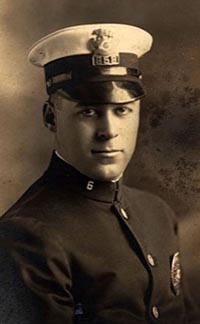
The name of Frank Stokes Greene appears on the Police Officer’s Memorial near the State Capitol building in Sacramento. Photo: Mark Tennis.
It was a little more than 60 years ago when a Coronado police lieutenant was shot and killed in the line of duty. It’s been even many more years since that officer once scored 11 touchdowns and 80 points all by himself in a California prep football game.
Note: For more on 1929 Coronado High football standout Frank Greene, CLICK HERE.
We hope you like this free post on CalHiSports.com. Please help us out today by becoming a member of our Gold Club so you can see all of our great state record book content, including list of most touchdowns scored for one game. For details, CLICK HERE.
If there’s ever a game in which a California high school football player has scored 10 touchdowns in a game, somebody better get a message to the head coach so that he (or her) makes sure that player does not score an 11th.
That’s because the Cal-Hi Sports state record of scoring 11 touchdowns in one game deserves to stay in the sole possession of Frank Greene, who did it during a 1929 game for Coronado High in a 108-0 victory over Sweetwater of National City.
In those days, Coronado only had a school enrollment of just over 300 and a roster of 18 players so it wasn’t like head coach A.E. Schaefer could have even taken out Greene from a lopsided contest even if he wanted to.
Still, once you know story of Greene, you’ll agree why his state record – perhaps more than any other – should stand by itself in perpetuity.
Playing Against Poly
Although the game against Sweetwater in which Greene scored 11 touchdowns and had 14 points on conversions for a single-game total of 80 points is the one that put him in the record books, the most memorable game for he and his Coronado teammates was the one played against Long Beach Poly.

Despite its low number of players, Coronado was one of the best teams in all of Southern California and with Greene and QB Johnny Lyons won the 1929 Southern Prep League championship. There were no playoffs in those days, but Coronado’s final game was against Poly, which was the champion from another league.
Even then, the Jackrabbits represented a huge student body and the enrollment differential was 3,500 for Poly to just over 300 for Coronado. It was a Hoosiers-style matchup in California football if there ever was one.
Although Coronado didn’t win on some miracle last-second play, the team battled on even terms with Poly for almost the entire duration. In the first half, Greene threw a touchdown pass and kicked the extra point to give Coronado a 7-6 lead. The small team than held on to that 7-6 lead midway into the fourth quarter. It wasn’t until the Jackrabbits completed two long passes to set up touchdowns that they eventually crafted a 20-7 victory.
Greene also was one of the top players in Southern California that season as well. He isn’t shown as the San Diego Player of the Year of the State Player of the Year since future USC legend Irvine “Cotton” Warburton was a junior at the time at San Diego High.
Still, Greene went on to star in college with Lyons at the University of Tulsa and is still regarded as one of the best players that that Oklahoma institution has ever had. When Greene was there, he ran and kicked Tulsa to victories over Oklahoma, Kansas and Arkansas.
That Fateful Night
In the early 1930s, after Greene had finished playing in college, pro football options for those like him were very limited. Nevertheless, he gave it a try anyway and for three seasons was a member of the Chicago Cardinals. He also helped coach and worked for a team in Los Angeles that was called the Bulldogs (later became the Rams).
After 1936, Greene began to think about heading home. He eventually became a member of the Coronado Police Department.
By 1954, when Greene was 43 and had a wife and teenage son (who was going to Coronado High), he had risen to the rank of lieutenant and would often be the acting Chief of Police if the Chief of Police was out of town.
On October 12, 1954, Greene took the night shift and was patrolling the streets of Coronado with Richard Lutsey, 35, a U.S. Navy shore patrolman.
At approximately 2 a.m., Greene and Lutsey stopped a car with three men inside near the public library and main plaza of the town.
According to newspaper accounts at the time, Greene walked to the driver’s window and looked inside. The driver exited the car and after a few moments Greene noticed a gun on the opposite floorboard. Lutsey later said a scuffle ensued and the driver, later identified at 27-year-old Robert Rodriguez, was able to pull out a different gun that he had in his waistband and shot Frank Greene in the head.
Lutsey leapt from the police car and immediately apprehended the passenger who was in the back seat, later identified as 39-year-old Benjamin Porozowski. Rodriguez and the other man, 35-year-old Rafael Gruber, who was in the front seat of the shooter’s car, fled on foot.
Nothing could be done for Greene. It was later reported that he likely died instantly.
What transpired after the shooting was called at the time in San Diego “the city’s record manhunt.”
If anybody knows Coronado, it’s an island with just one southbound road to exit in and out from and that road was immediately sealed off. With the aid of the U.S. Coast Guard and U.S. Navy patrolmen, the island was effectively sealed and eventually a massive total of 5,000 homes was searched, one by one.
By 1:15 p.m. the next day, Rodriguez was captured while hiding in an attic at a hotel. Gruber remained at-large for nearly 24 hours until he turned himself in at the U.S. border with Mexico. The rumors were that if he’d been seen in Mexico, that authorities there (who knew of the case) would have simply killed him on sight.
All three suspects were eventually tried and convicted of murder and reportedly received life sentences. It also was later revealed that they were workers at the famous Hotel Del Coronado who were planning to go on a robbery spree when they were stopped by Greene and Lutsey.
Greene’s death would have shaken up the San Diego community regardless, but as a former local sports sports hero it perhaps shook it up even worse.
Wrote legendary San Diego sports columnist Jack Murphy two days after the shooting: “Frank Greene was a man who could cope with any situation. But his killer didn’t give him a chance.”
So the next time you see Frank Greene’s name mentioned whenever someone in California scores nine or 10 touchdowns in a game, remember that there’s more to that name than just a line in a record book. His name also appears on the Police Officer’s Memorial in Sacramento. It truly represents a state record that should last forever.
Mark Tennis is the co-founder and publisher of CalHiSports.com. He can be reached at markjtennis@gmail.com. Don’t forget to follow Mark on the Cal-Hi Sports Twitter handle: @CalHiSports






One Comment
Great column. I hope your advice is heeded.